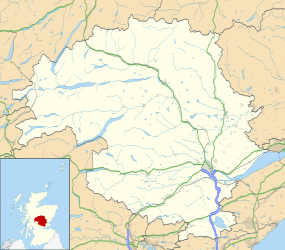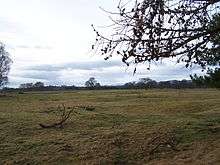Inchtuthil
Coordinates: 56°32′28″N 3°25′26″W / 56.541°N 3.424°W
| Inchtuthil | |
|---|---|
|
Aerial photograph of the fort site | |
 Inchtuthil | |
| OS grid reference | NO1239 |
| |
Inchtuthil is the site of a Roman legionary fortress situated on a natural platform overlooking the north bank of the River Tay southwest of Blairgowrie, Perth and Kinross, Scotland (Roman Caledonia).
It was built in AD 82 or 83 as the advance headquarters for the forces of governor Gnaeus Julius Agricola in his campaign against the Caledonian tribes. Positioned at the head of one of the main routes in and out of the Scottish Highlands, it was occupied by Legion XX Valeria Victrix and covered a total area of 21.5 hectares (53 acres).[1] Construction of the large fortress would have taken two or three seasons and a temporary camp was built nearby to house and protect the soldiers over the winter. Additional, smaller forts were built further north and south at the mouth of each nearby glen forming what are now referred to as the Glenblocker forts.
Woolliscroft and Hoffmann [2] argued that the Glenblocker forts, as well as others in Strathmore, such as Cardean and Stracathro, formed a uniform system composed of several elements, the forts and watchtowers on the Roman road of the Gask Ridge, the Glenblockers and the Strathmore forts. Inchtuthil as the largest military base would have functioned as the lynch-pin and the only site large enough to launch an invasion into the Highlands and beyond.
Layout and garrison
Unlike other legionary fortresses in Britain, Inchtuthil was not later built over and its layout was still largely preserved when Sir Ian Richmond excavated it between 1952 and 1965.[3] It is therefore notable as the site which provides the only complete plan of a legionary fortress anywhere in the Roman empire. Its defences consisted of a turf rampart faced with stone, with an outside ditch and gatehouses on each side, following the standard Roman plan. The legion it accommodated would have numbered 5,400 at full strength, though there would have been additional specialist troops accompanying them.[4]

Facilities included a hospital (valetudinarium) that covered 5,000 square metres, a workshop covering 3,500 square metres and 64 barrack buildings. The timber walls of these buildings have been calculated to have had a total perimeter of seven miles (10 km).[5] A headquarters building containing an aedes where the legion's colours and images of the emperor would have been kept has also been identified in the insula in the centre of the fortress. However, it was much smaller than would be expected for a legionary fortress, and must have been of a temporary nature. The large empty insula to its east should have been the site for the Praetorium, the commander's house. However, no signs of building foundations for such a large structure were found though the site had been levelled and prepared.[6]
Inchtuthil was only briefly occupied and was evacuated around summer AD 86 and certainly no later than early in AD 87. The reason for this was probably that Legio II Adiutrix had been called to Moesia from its base in Deva Victrix (Chester) to deal with a Dacian invasion in 86 and XX Valeria Victrix was obliged to move back south to take its place. However recent archaeology has cast some doubt on this, indicating that the fortress may have been in use for considerably longer than previously thought.
The Inchtuthil hoard
When it was excavated in the 1950s by Richmond a large pit was found containing more than 750,000 iron nails and other iron objects weighing a total of ten tonnes. The pit was elaborately concealed, and the nails and ironwork were almost certainly buried by the troops to deny them to the local tribes when they dismantled the fortress before they finally left. Many of the nails were sent to museums as a gift and the rest of the hoard was stored at a steel works in Motherwell, where it was eventually recycled.[7]
The almost 2000-year-old iron Inchtuthil nails have been used by atomic scientists to estimate the corrosion effects on barrels of nuclear waste.
Bibliography
- Breeze, D. 1982 Northern Frontiers of Roman Britain. London: Batsford
- Pitts, L. F. and St.Joseph, J. K. 1985. Inchtuthil. The Roman Legionary Fortress Excavations 1952-65 (Britannia Monograph Series 6). London: Society for the Promotion of Roman Studies.
- Shirley, E. A. M. 1996. "The Building of the Legionary Fortress at Inchtuthil", Britannia Volume 27. pp 111–128.
- Shirley, E. A. M. 2000. The Construction of the Roman Legionary Fortress at Inchtuthil (British Archaeological Reports, British Series 298). Oxford: Archaeopress
- Woolliscroft, D. J. and Hoffmann, B. 2006. Rome's first frontier: The Flavian occupation of northern Scotland Stroud: The History Press:
References
- ↑ Keppie, Lawrence (1984). The making of the Roman army from Republic to Empire. London: Batsford. pp. 174–5. ISBN 0-7134-3651-4.
- ↑ D.J.Woolliscroft, B.Hoffmann, The First Frontier. Rome in the North of Scotland (Stroud: Tempus 2006)
- ↑ Roger J.A.Wilson "A Guide to the Roman Remains in Britain" 2002 Constable, London ISBN 1-84119-318-6 pp596-598
- ↑ Flavius Vegetius Renatus, N. P. Milner, Vegetius: Epitome of Military Science, 1996, Liverpool University Press, 161 pages ISBN 0-85323-910-X
- ↑ Keppie, Lawrence (1984). The making of the Roman army from Republic to Empire. London: Batsford. p. 175. ISBN 0-7134-3651-4.
- ↑ John Wacher, Roman Britain, J.M.Dent & Sons Ltd., London 1978 p40
- ↑ "The Inchtuthil Nail Hoard". Roman Scotland. 2008. Retrieved 2014-04-30.
External links
| Wikimedia Commons has media related to Inchtuthil. |
- RCAHMS/SCRAN educational site for Inchtuthil
- RCAHMS/SCRAN educational site for the medical facilities at Inchtuthil
- Italian scholarly disertation, in English, well sourced and illustrated, about Inchtuthil
- The Roman Gask Project
- romanbritain.org Northern Campaigns
_p%C3%A5_tre_sidor..jpg)